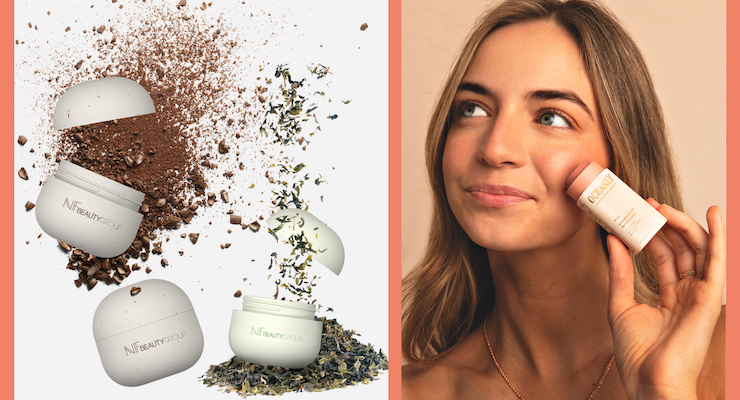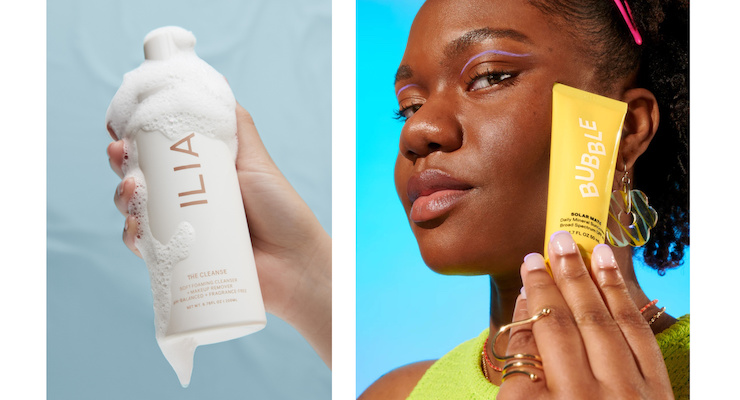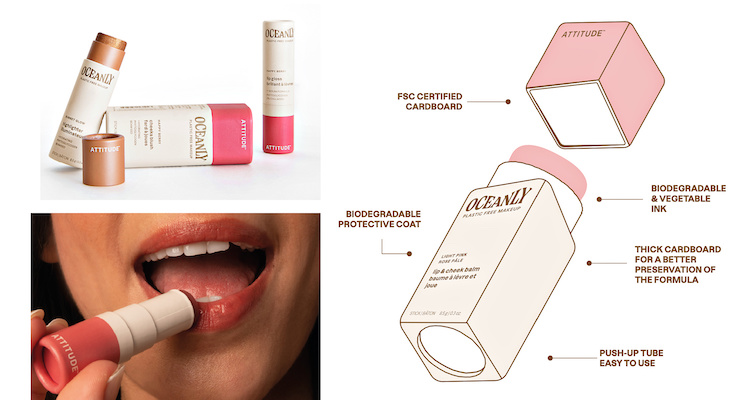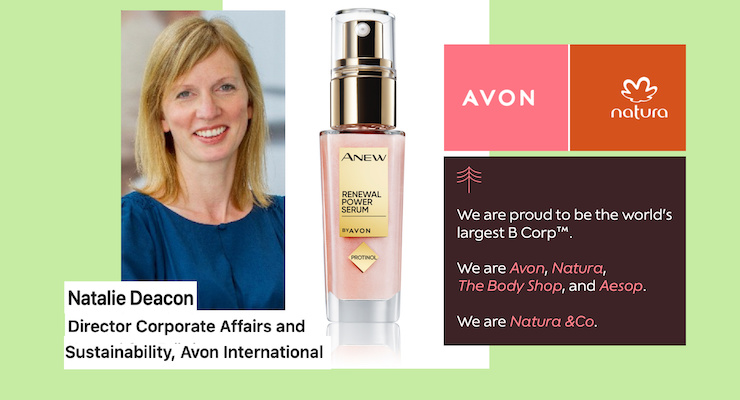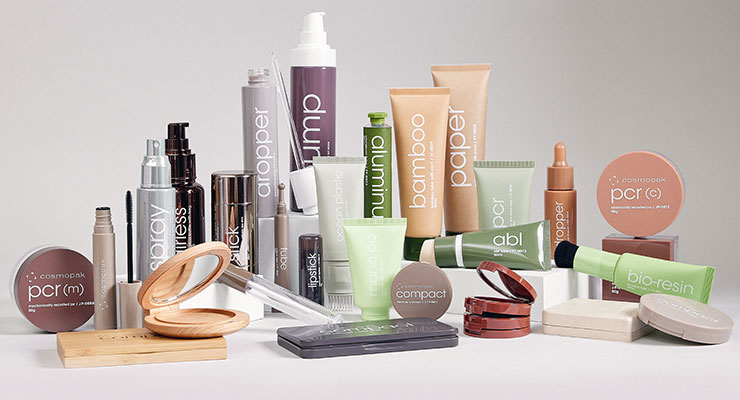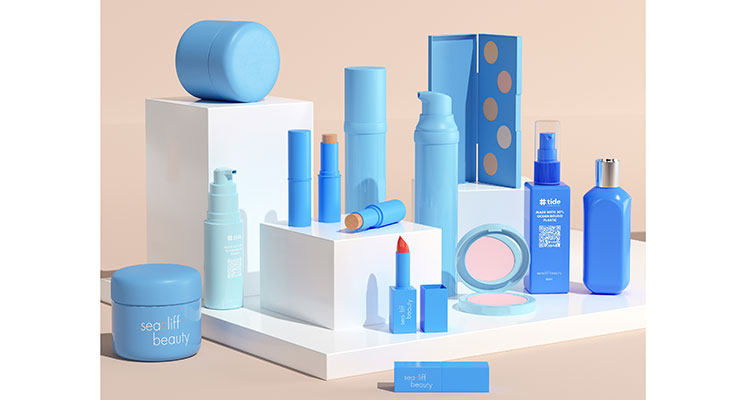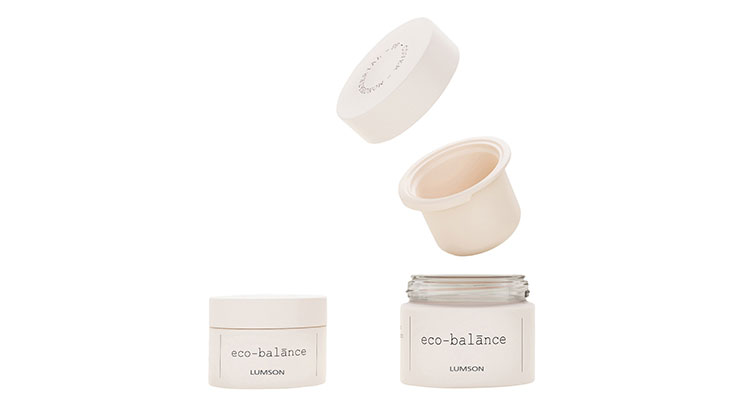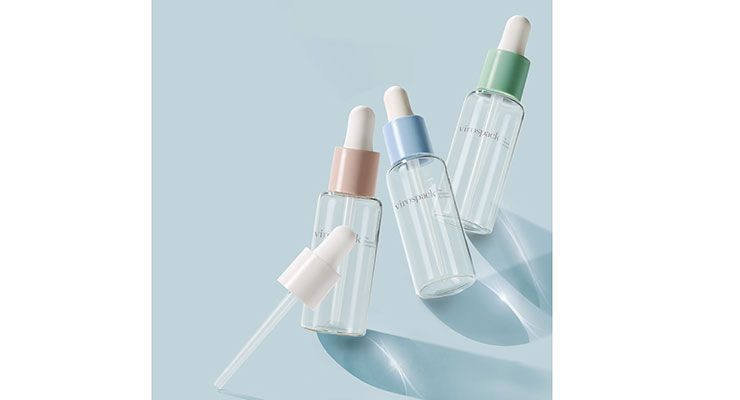Marie Redding, Senior Editor08.23.23
The beauty industry is evolving—‘clean’ ingredients are becoming the norm, and the demand for sustainable packaging is soaring. The global clean beauty market was valued at $7.22 billion in 2022 and is expected to reach $14.36 billion by 2028, growing at a CAGR of 12%, according to a report from Research and Markets. The global sustainable packaging market size was valued at $101.49 billion in 2022 and is projected to rise to $211.51 billion by 2032, growing at a CAGR of 7.62% according to Precedence Research.
Experts say more beauty brands are adopting clean beauty standards. “Even brands that do not explicitly label themselves as ‘clean’ are integrating certain elements and drawing inspiration from the clean beauty movement,” says Cassandra Boler, marketing director at Cosmopak.
Attitude, a Canadian-based brand that’s EWG-Verified, cruelty-free, and vegan, has a mission to use clean ingredients. Its new Oceanly collection is in plastic-free packaging. The company has an in-house lab, factory, and a plastic-free boutique in Montreal that aims to connect beauty consumers with the environment on an emotional level, through design. (See below for more about Attitude’s Oceanly makeup.)
Smaller companies, such as Attitude, and Indie brands, remain the first pioneers of the clean beauty movement—and are continuing to help move the industry forward. But larger companies are following suit.
Avon is one of the many brands on a mission to use more natural ingredients and sustainable packaging—and will soon be bringing cruelty-free beauty to the masses. A part of Natura & Co. Group, Avon announced in July that it began its journey to become Leaping Bunny approved in partnership with Cruelty Free International. Avon says it will become the first global cosmetics company to end animal testing in all of its operating countries. (Avon bases this claim on data compiled by Euromonitor in 2019 on the top global cosmetics companies and their animal testing policies.)
“The challenge for us is always how do we adopt what may be a niche concept while still serving millions of customers?” asks Natalie Deacon, Avon’s director of Corporate Affairs and Sustainability. But she already knows the answer, explaining, “We know that millions of our customers are taking more of an interest in sustainability and the impact of their purchases on the planet—our sales reps tell us. They care about this and expect us to take action,” she says. (See more about Avon’s journey to become more sustainable and cruelty-free, below.)
Experts say beauty consumers are demanding these products, but change can be slow. Many larger brands are reformulating products without controversial ingredients, and announcing additional deadlines to improve packaging’s sustainability. “Mass market brands implement changes slowly because tackling the price point can be an issue—and making changes on a huge scale is no easy task,” says Andrea Greff, design and marketing manager at NF Beauty. “Indie brands are more agile and typically begin with a full sustainable story, and clean formulas are often a part of their mission from the ground up,” she says.
Cosmopak offers comprehensive turnkey solutions for brands looking for easier ways to launch clean beauty formulas and sustainable packaging. “Our turnkey approach provides brands with end-to-end support in developing product lines,” says Boler. “We created our own framework to define sustainability, called ‘ecoforward.’ It serves as a guide to help brands, as we help them explore each option in detail to identify the most suitable approach and clarify the unique benefits of each,” Boler explains.
Cosmopak’s “Rooted in Beauty” collection for 2023-24 showcases a variety of sustainable packaging options, including innovative materials such as paper, bamboo and ocean-bound plastic. There are also mono-material packaging solutions in PP, PCR tubes, and more.
Clean Ingredients & Retailer Guidelines
Retailers help concerned consumers make purchasing decisions with programs and “clean beauty shops,” including Clean at Sephora, Conscious Beauty at Ulta, the Credo Clean Standard, Target Clean—and now, Clean Beauty at Walmart.The Clean Beauty at Walmart program launched in March and offers concerned consumers more affordable options. There are more than 900 clean beauty products made without over 1,200 ingredients on the retailer’s “Made Without List” (MWL)—and nearly 80% under $10.
“We reviewed state and federal regulations, consulted suppliers, and called on experts such as the Environmental Defense Fund. And we listened to customers, who increasingly desire products without certain ingredients as well as better transparency around what goes into them. That’s how we ended up with over 1,200 ingredients on the MWL,” explains Creighton Kiper, vice president of beauty at Walmart.
Cosmopak’s Boler says when retailers launch new guidelines, it is more confusing for beauty brands to keep up with compliance. “The landscape of clean beauty and sustainable packaging, and all that entails, is constantly evolving. Retailers, geographical regions, third-party organizations, and governments all have their unique compliance standards, and it is progressively challenging for brands,” she explains. Cosmopak often helps brands navigate these changes by reformulating products and redesigning packaging.
Sephora updates its banned ingredient list annually. “This can pose additional challenges,” says Boler. “We actively monitor every retailer’s clean beauty requirements—along with each formula we produce—to ensure compliance. As a result, we find ourselves proactively reformulating products,” she explains.
NF Beauty’s Greff says that in addition to avoiding “blacklisted” ingredients, beauty consumers are paying more attention to a product’s biodegradability. “We all better understand the impact of products on our environment. Brands are taking note and using more natural ingredients,” says Greff. (Avon focuses on biodegradable ingredients; see more about this below.)
Sustainable Materials Are In-Demand
We’ve seen mushroom paper, hemp products—and other sustainable material innovations. What’s next on the horizon? “We see an increase in inquiries regarding alternative materials with a focus on using bio-wastes or bi-products from other industries,” says NF Beauty’s Greff. “These include the agricultural industries of rice production, tea production, coffee production—and even the limestone and stone quarry industries,” she says.Beauty brands often try to decide which types of packaging are truly the most sustainable, but there is no single answer. “Sustainable packaging holds a unique significance for every brand, reflecting their individual values and aspirations—and there’s an array of choices,” says Erin Gallagher, director of marketing, APC Packaging. “We prioritize understanding a brand’s objectives and sustainability targets,” she says. APC Packaging is a leader in skincare solutions and offers pumps, jars, and tubes that are refillable, made with PCR, or mono-material designs for easy recycling. “PCR is the top most requested option,” says Gallagher. “We have a certified source for PCR to ensure quality and availability,” she says.
Vonda Simon, founder and CEO of Seacliff Beauty, says there is still a lot of confusion over deciding on the most sustainable materials due to recycling issues. “Until the recycling process improves, we believe using our #tide Ocean Material helps. It removes plastic waste from oceans to create packaging. Ideally, the packaging will be recycled and repurposed, closing the loop,” Simon says.
In addition to its ocean plastic, Seacliff offers a variety of sustainable packaging options. Simon says the choice depends on a brand’s goals. “Some beauty brands want to be plastic-free, so they choose glass. Others want to follow specific retailers’ guidelines, which could allow for more flexibility, such as PCR, ocean-bound plastic, or refillable solutions,” Simon explains.
NF Beauty offers sustainable packaging in PCR, mono-material designs, and alternative materials. “We are excited about our Eco-Jar,” says Greff. “It is fully recyclable, with a glass jar base and an aluminum cap. Both the inner and outer parts of the cap are aluminum, and our Easy Peel Liner makes it easy for consumers to separate before recycling,” she explains.
Lumson says its ability to offer innovative sustainable packaging is one of the foundations of its portfolio. The supplier offers lightweight airless packages in aluminum, PE, and paper. “Our range includes refillable glass jars, and we are working toward expanding our refillable offerings,” the supplier says. Lumson’s other options include PCR glass bottles and jars, PCR aluminum airless systems, and mono-material dropper and cover packs. “All of our airless systems with pouch technology are specifically studied to be separated after use and disposed of in the appropriate recycling chain,” Lumson’s R&D team explains.
Refillable Options—And More Material Insights
Glass, PCR, paperboard, and other materials can all be useful in creating sustainable packaging. Analyzing the pros and cons of each is often a challenging decision—and suppliers step in to help. No matter the material, there is an increasing demand for refillable packaging, and suppliers are offering new options to meet demands.Verena Fiori Ferreira, global marketing & communications director, Virospack, says there is an increasing demand for all types of packages in PCR. The supplier offers a PCR dropper pack that can be recycled without disassembly. “The pipette and cap are made of PCR PP, and the bulb is produced with a TPE that can be recycled with PP,” says Ferreira. “There are more options in the market for PCR, and the fact that current prices are approximately the same as the virgin material helps brands make that choice,” she says.
Virospack is also developing a new refillable package that will launch with a bio-based dropper. “It will meet the highest quality requirements and all the components will be more than 50% bio-based,” says Ferreira. “The cap is 100 % plant-based, due to a collaboration with Rezemo GMBH,” she says. Virospack is in the process of redesigning its standards to reduce weight, while also redefining its production processes to reduce waste and save energy. “We also have many PCR and bio-based options,” Ferreira says.
Miren Diaz, global creative director at Asquan, says glass is in demand. “Glass is on the forefront of the sustainability push—and we have a fully curated library of glass options to fill this growing trend.” Asquan offers a refillable glass airless pump range. “It delivers sustainability while still retaining a luxe look and feel,” she says. “We are also seeing more requests for aluminum as a keepsake package. It can elevate a product and make it feel substantial,” she adds.
Asquan has an in-house design team, and the supplier specializes in all types of sustainable materials, including recyclable PET, PP, PCR, PIR, glass, and aluminum. “As styrene materials are becoming banned worldwide, we have been working diligently with all our factory partners in reimagining our standard offerings into non-styrene materials,” explains Michelle Wong, Asquan’s executive director of design & innovation. The supplier’s Clarity Collection includes styrene-free round and square compacts and lip gloss packages.
Asquan’s award-winning refillable Soft Square Collection includes a jar, an airless pump, and a dip tube pump, which easily disassembles for recycling. “Our newest Asquan standards are all 95-100% recyclable and/or refillable,” says Wong.
The team at HCP says refillable packaging is often the best option, and the company’s new refillable jar has many innovative properties. “Refillable jars are not new, but many designs are awkward to handle, especially when removing inner pods,” says Cheryl Morgan, creative marketing manager at, HCP Global.
HCP’s new Ringo Refill Jar is designed for easy disassembly. “Secured with a click-fit within the recess of the outer jar, the refillable inner pod can be released with a unique and effortless push-out gesture from the underside. The inner pod can be decorated or used to display base label information clearly at all times,” Morgan says.
The jar’s refillable inner jar reduces environmental impact, while its weight is significantly reduced due to its outer jar ‘ring’ design,” says Morgan. “The PP refill pod forms the base,” she says. HCP can produce the jar in recyclable PET, PP, and PE. “After disassembly, it is easily recycled in domestic waste streams,” she explains.
What’s Next for Sustainable Packaging?
Continually improving packaging’s sustainability will be an ongoing goal for nearly every beauty brand, suppliers say. “Sustainability is now the main driver for packaging, compared to years ago when choices were still more marketing-oriented, and proposals were aimed at capturing the consumer’s attention,” Lumson’s R&D team says.At Asquan, Diaz predicts a “less is more” approach to beauty packaging will continue. “Consumers want to see longevity in their packaging, with less waste,” she says. “There will continue to be an uptick in demand for refillable beauty in the prestige sector, especially for haircare, skincare, and makeup,” she says.
Lumson’s R&D team adds, “Sustainability is a long-term path with a clear goal—to shape the future of packaging with due regard for the environment and humanity.”
Avon Talks More In-Depth About Its Goals
Avon is set to become 100% cruelty-free by next year—here’s more about the process.Avon is working toward using cleaner ingredients, sustainable packaging—and will soon be 100% cruelty-free. A part of Natura &Co., Avon recently received Leaping Bunny approval for its Fragrance, Avon Care, and Anew ranges. “We have a long-standing commitment to animal welfare and have been promoting non-animal testing methods for three decades—so we’ve been talking for a long time about the best way to accomplish this. We had some processes and measures already in place,” says Natalie Deacon, Avon’s director of Corporate Affairs and Sustainability.
Avon will also ensure that 90% of its formulas are biodegradable by 2030. The new Hydramatic Matte Lipstick contains bio-fermented hyaluronic acid, created using a renewable biotech process. Avon’s 12 new Glimmerstick eyeliners average 98% biodegradability, and 6.8 million were sold last year.
As for packaging, nearly 80% of all Avon’s packaging is now reusable, recyclable, or compostable—and Deacon says it will get to 100% by 2030. The company reduced its plastic packaging by 36% last year. Several product ranges were relaunched in packaging made with less plastic, and Avon Anew Hydrating Overnight Mask is one example. It’s in a lighter-weight tube made with less plastic and a higher level of PCR.
Avon’s journey to become cruelty-free is no easy feat. The company had to rigorously audit its entire supply chain to ensure compliance with a strict set of criteria to obtain the Leaping Bunny approval—and display the symbol on its packaging.
“We’re unique in that Avon is both the store and individual brands, so the scale of this project is enormous,” Deacon says. “It requires us to implement a supplier monitoring system, down to the ingredient manufacturer level, and it’s a rigorous auditing process because we work with over 2,000 suppliers—but we’ve got to give consumers that guarantee,” she explains. Avon had to adhere to a fixed cut-off date policy and will also allow regular independent audits to ensure ongoing compliance.
To help create a better world, Avon’s focus is on sustainability and using biodegradable ingredients. The company launched its critical material policies last year, with action plans covering palm oil, paper, cotton, soya, mica, and ethanol, which are sometimes associated with social or environmental risks, such as deforestation. Clear standards on traceability will ensure these materials are sourced in a sustainable way. Avon says it is also striving to include more plant-based and synthetic ingredients into its products without having a negative impact on the planet and its resources.
Avon is also focusing on sustainable packaging. “We have to make sure our products are recyclable, but also that they’re being recycled,” Deacon says. “We don’t claim that a package or material is recyclable unless it is actually being recycled in that location. This varies from region to region, and industry standards are lacking. We’ve got to help consumers navigate this complex moment we find ourselves in—and tackling this on a global level is a challenge, to say the least.”
Avon has remained focused on conducting feasibility studies to understand in detail how its packaging—and beauty product ingredients—are contributing to its carbon footprint. The company reduced energy use across all its factories and distribution centers.
Last year, Avon used 47.7 tons of PCR material in its packaging instead of virgin plastic. Overall, .06% of all its plastic packaging was PCR—and the company has a plan to get to 50% by 2030—while also ensuring that all packaging is reusable, recyclable, or compostable. Avon’s research and development packaging team uses the Sustainable Packaging Initiative for Cosmetics (SPICE) Lifecycle Assessment Tool to drive packaging innovation decisions during product development.
Attitude’s New Oceanly Makeup in Solid Stick Formats
Attitude has launched its first color cosmetics line, Oceanly Makeup—and says it’s the first-ever solid makeup collection to be EWG Verified. The products are all in solid stick format and packaged in biodegradable paper tubes, so the collection is 100% plastic-free.“Attitude has been tirelessly focused on developing clean and performance-driven beauty products. Oceanly is our most game-changing advancement to date—it’s clean, vegan, and plastic-free,” says Jean-François Bernier, chief executive officer. Oceanly Makeup includes 28 sheer-coverage products that are vegan and cruelty-free. Oceanly’s Foundation Stick, Tinted Oil, Eye Concealer, and Lip Gloss are made with 99.9% natural-origin ingredients, while the Bronzer Stick has 99.7% and the Blush Stick has 99.6%, followed by the Highlighter with 94.5%.
The formulas are all hydrating with a “star” ingredient, phytoglycogen. “It’s 100% plant-derived and eliminates the need to extract glycogen from shellfish, helping preserve marine ecosystems,” says Julie Ramos, vice president of marketing at Attitude. Non-nano zinc oxide is used in place of titanium dioxide. “Titanium dioxide is often used in makeup as a pigment and brightener, but it may be carcinogenic when inhaled,” Ramos says. “And since we’re vegan, we had to find an alternative to carmine, the red dye that is used for lipstick, blush, and eye shadows. Carmine is made by drying, crushing, and boiling cochineal beetles,” says Ramos. “It’s terrible to think that somewhere out there is a beetle factory,” she says.
The paper tube packaging is an innovative push-up design with a biodegradable protective coating. Implementing eco-packaging has never been an option, but a necessity,” says Sarah Rajaobelison, operations director at Attitude. “Our operations team developed the plastic-free packaging, and regulatory specialists checked that plastic-free tubes complied with regulations, our sustainability standards and certifications at all levels,” she explains.
“Our laboratory worked consistently on formulations to guarantee that there will be no interactions with the selected ingredients and to understand how materials behave,” she adds.
There are always challenges when makeup products are packaged in paper. “Cardboard loves water and soaks it up,” Rajaobelison says. “Our packaging is biodegradable because it disintegrates. If we want to add hydrophilic ingredients, we must stabilize them or add less—to avoid destabilizing the packaging. We needed a paper that the makeup wouldn’t stain,” she explains.
The packaging is made from FSC-certified paperboard from eco-managed forests. It is decorated with biodegradable and vegetable inks. “We made sure the push-up tube is easy to use,” says Ramos. “And the thicker cardboard helps preserve the formula. The thickness is important to limit the amount of water in contact with the packaging—or it will swell and disintegrate,” says Ramos. “The thickness also helps act as a barrier to keep the formula’s ‘fattier’ raw materials intact, without seeping through and staining the tube,” she explains.
ILIA Continues Skincare Expansion
ILIA Beauty, known for its clean makeup formulas, has expanded into skincare. ILIA launched Bright Start Activated Eye Cream earlier this year, followed by its new “The Cleanse” Soft Foaming Cleanser and Makeup Remover. It contains Pentavitin 0.5%, a hydrating plant-derived sugar complex, and Barsolve 1.5%, a gentle emulsifier.ILIA says rather than use a heavier glass bottle, the makeup remover is in a plastic bottle with a foaming pump. “Glass is a heavier material that would increase our carbon footprint when shipping,” the brand states. The Cleanse is in a plastic bottle that’s easy to recycle and made with 30% post-consumer HDPE and PP. Its foaming pump and plant-based surfactants produce a rich lather.
ILIA is Leaping Bunny certified, and its products don’t contain BHA/BHT, chemical screens, Cyclomethicone, gluten, mineral oil, parabens, PEGs, petrolatum, phthalates, propylene glycol, and talc.
Bubble’s Sunscreens Took 3 Years to Develop & Over 100 Iterations
Bubble launched two clean sunscreens that deliver lightweight moisture to the skin and feel like a primer. Solar Mate is the brand’s invisible SPF and Plus One is a tinted SPF formula to give skin a blurring “glowy” look.The team at Bubble considered over 100 product variations for over three years before they were happy with the formulas. “We had to be sure we were giving our customer the best product, while keeping the price under $20,” says Shai Eisenman, founder and CEO of Bubble. “The biggest barriers to SPF are finding a formula that leaves no white cast, doesn’t break you out, has no ‘sunscreen’ smell, and is easy to apply—all for an accessible price point. We are so proud of our formulations that are truly fragrance-free and leave no white cast regardless of skin tone,” Eisenman explains.
Solar Mate includes the antioxidant raspberry seed extract; hydrating cocoa seed butter; and glycerine for its lightweight gliding texture. Plus One includes milk thistle, a silicone alternative; and lilac extract for its mattifying properties. “There is so much fear-mongering in the beauty industry—so many ingredients are controversial, but not all of them are bad,” says Eisenman. That said, Bubble’s list of “banned” ingredients is impressive. The brand won’t use PEGs, PPGs, polysorbates, sulfates, phthalates, parabens, cyclic silicones, animal-derived ingredients, added fragrances—and more.
Bubble chose an airless tube, which delivers a mess-free easy application, after considering multiple packaging options. The tube is a custom color and silk screened. It is made from medium-density polyethylene (MDPE), paired with a cap and pump in PP. “We work with Terracycle to recycle our packaging. We also work with Eco Drive, where one tree is planted for each e-commerce purchase, helping to offset our carbon emissions.”

